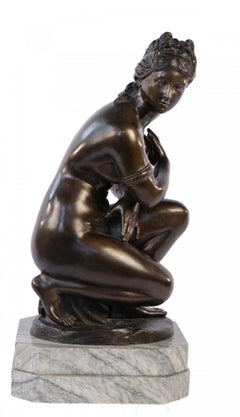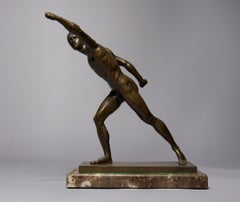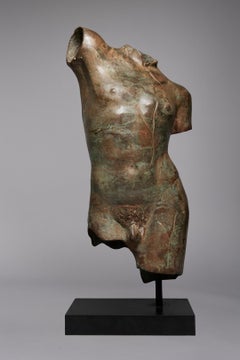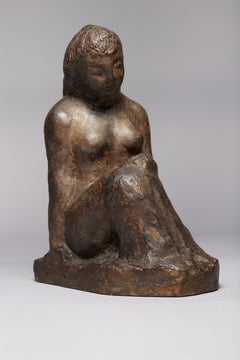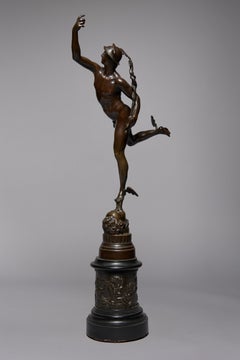WOLFS Nude Sculptures
to
14
8
6
2
Overall Width
to
Overall Height
to
1
13
16
1
4
1
1
1
3
28
24
21
19
14
7
4
4
3
3
2
1
1
1
1
1
1
1
23
23
11
10
3
3
2
1
1
1
30
Figure of Crouching Venus/Naked Aphrodite, 19th Century Italian School Sculpture
Located in Beachwood, OH
Bronze Figure of Crouching Venus, or The Naked Aphrodite, 19th Century Italian School
Bronze raised on a marble base
21 in. h. x 10 in. w. x 7 in. d., overall
18 in. h. x 8.5 in. w....
Category
19th Century Figurative Sculptures
Materials
Marble, Bronze
19th Century Bronze of the Borghese Gladiator Sculpture
Located in Beachwood, OH
The Borghese Gladiator, 19th Century
Bronze on marble base
Musée du Louvre signed on base
15 x 12 x 8 inches
Since its discovery in the early seventeenth century, the Borghese Gladi...
Category
19th Century Figurative Sculptures
Materials
Marble, Bronze
Patinated Bronze Torso after the Antique, 19th/20th Century
Located in Beachwood, OH
Patinated Bronze Torso after the Antique, 19th/20th Century
Bronze
Torso: 22 x 13 x 11 inches
Including base: 27 inches high
Category
Late 19th Century Figurative Sculptures
Materials
Bronze
Seated Nude Woman Sculpture, Early 20th Century
By William Zorach
Located in Beachwood, OH
William Zorach (American, 1887-1966)
Seated Woman
Painted plaster
Inscribed underside "V"
12.5 x 9 x 5 inches
Provenance: The Tatti Family Collection
Bill Zorach was born in Lithuan...
Category
Early 20th Century Figurative Sculptures
Materials
Plaster
Mercury Standing on the Breath of Zeus, Antique Grand Tour
By Giambologna
Located in Beachwood, OH
After Giambologna (Italian, 1529-1608)
Mercury Standing on the Breath of Zeus
Bronze
27.5 x 14.25 x 5.5 inches
The sculpture depicts Mercury wearing his winged helmet and sandals and holding a caduceus. Created after one of Giambologna's most celebrated sculptures in the Renaissance, Mercury, was designed as part of a fountain for the Villa Medici in Rome.The head on which Mercury steps symbolizes the figure being “exhaled, purified, unburdened.” When the Giambologna sculpture...
Category
19th Century Figurative Sculptures
Materials
Bronze
20th Century French School Large Bronze Sculpture of a Semi-Nude Dancer
Located in Beachwood, OH
20th Century French School
Dancer
Patinated bronze
38 x 18.5 x 9 inches
Provenance: The Tatti Family Collection
Category
20th Century Figurative Sculptures
Materials
Bronze
Sleeping Ariadne, Large Bronze & Marble Sculpture of Greek Mythology, 19th C.
By Pietro Chiapparelli
Located in Beachwood, OH
Pietro Chiapparelli (Italian, 19th Century)
Sleeping Ariadne, c. 1865
Bronze on marble base
Inscribed 'P. Chiapparelli F.I. Roma'
22 x 24 x 10.5 inches
136 lb.
(34 lb. bottom marble,...
Category
1860s Figurative Sculptures
Materials
Marble, Bronze
19th Century Grand Tour Bronze of the Uffizi Wrestlers
Located in Beachwood, OH
After Lysippos (Greek, 390 BC-300 BC)
19th Century Grand Tour Bronze of the Uffizi Wrestlers
Bronze
J. Chiurrazi & Fils, Naples
17 x 20 x 12 inches
76 lb.
The Wrestlers is a Roman m...
Category
19th Century Figurative Sculptures
Materials
Bronze
Contortionist Nude, 20th Century Bronze of Nude Female, Cleveland Artist
Located in Beachwood, OH
David Deming (American, 20th Century)
Contortion Nude
Bronze
Signed on base
14 x 12 x 9 inches
David Deming is a nationally recognized contemporary Ameri...
Category
Late 20th Century Figurative Sculptures
Materials
Bronze
Italian Bronze Sculpture of Nude Woman, Mid 20th Century
Located in Beachwood, OH
Mario Spampinato (Italian 1912–2000)
Nude
Bronze
Signed on base
17.5 in. h. x 5.75 in. w. x 6 in. d.
The artist was born, raised and trained in Italy. During one of his exhibits (at San Marcos in Rome) the Director of a New York Gallery asked him to come to New York to work for him. The American Consul, before issuing his visa, asked Spampinato to create a bust of him. In exchange, the Consul paid for his passage on the boat to New York. In New York, he worked with his brother Clemente Spampinato who is a well known sculptor as well.
After moving to Chicago in 1954, he discovered that there was no foundry in the Midwest that could cast his bronzes. So, he opened his own foundry called the Spampinato Art Foundry, casting in the lost wax process. He also started his own private school (Spampinato Art Workshop, Ltd) and did some teaching at the University of Chicago and conducted seminars at Lawrence University in Kansas.
Many of his own works are pictured and cataloged in Volumes 2 & 3 of Bronzes: Sculptors and Founders, 1800-1930 by Harold Berman.
Between 1959 and 1967, Spampinato recast a number of Charles M Russell...
Category
Mid-20th Century Figurative Sculptures
Materials
Bronze
Frine (Phryne), 19th Century Large Marble Sculpture of Nude Woman
Located in Beachwood, OH
Ercole Rosa (Italian, 1846 - 1893)
Frine (Phryne)
Marble
Signed 'E. Rosa, Studio O. Andreoni, Roma' on back
34.5 x 12 x 10 inches
80 lb.
Phryne was a 4th century BC famous Greek ...
Category
19th Century Italian School Figurative Sculptures
Materials
Marble
Female Nude Godiva Riding a Rhinoceros Sculpture, 20th Century
By John Kearney
Located in Beachwood, OH
John W. Kearney (American, 1924-2014)
Godiva on a Rhinoceros
Bronze
Signed with monogram to base
6.5 x 3 x 8.5 inches
Born in Omaha, Nebraska, he studied at the Cranbrook Acadamy of...
Category
Late 20th Century Figurative Sculptures
Materials
Bronze
20th Century Reclining Female Nude Marble Sculpture, Cleveland School Artist
By Max Kalish
Located in Beachwood, OH
Max Kalish (American, 1891-1945)
Reclining Nude
Marble
Signed on base
9 x 20.5 inches
Born in Poland March 1, 1891, figurative sculptor Max Kalish came to the United States in 1894,...
Category
Mid-20th Century Figurative Sculptures
Materials
Marble
Grand Tour Bronze Figure of Seated Hermes, Early 19th Century After the Antique
Located in Beachwood, OH
Large Figure of Seated Hermes, Grand Tour Bronze, Early 19th Century
19th Century Continental School After the Antique
The large size figure well cast, with brownish green patination...
Category
Early 19th Century Figurative Sculptures
Materials
Marble, Bronze
Psyche Revived by Cupid's Kiss, Large Marble Sculpture after Canova, 19th C.
By Antonio Canova
Located in Beachwood, OH
After Antonio Canova (Italian, 1757-1822)
Psyche Revived by Cupid's Kiss
Marble
24 x 19 x 16 inches
135 lb.
The love affair between Cupid and Psyche is one of the best known classic...
Category
19th Century Figurative Sculptures
Materials
Marble
Woman and Child, Early 20th Century Ceramic, Female Cleveland School Artist
Located in Beachwood, OH
Thelma Frazier Winter (American, 1903-1977)
Woman and Child, c. 1935
Glazed stoneware, painted plaster
14 x 7 x 5.875 inches
Thelma Frazier Wint...
Category
1930s Figurative Sculptures
Materials
Stoneware, Plaster, Glaze
Zinnia, early 20th century sculpture of nude bust of woman, Cleveland School
Located in Beachwood, OH
Walter Sinz (American, 1881-1966)
Zinnia, c. 1930
Plaster
Signed on base
9 x 8 x 4 inches
Walter A. Sinz was an American sculptor born in Cleveland, Ohio on July 13, 1881. Sinz’s fa...
Category
1930s Figurative Sculptures
Materials
Plaster
First Steps, Early 20th Century Bronze Sculpture, Cleveland School
By William Zorach
Located in Beachwood, OH
William Zorach (American 1891-1966)
First Steps, 1918
Bronze
8.5 x 5 x 4 inches, including base
Born in 1887 in Lithuania, William Zorach immigrated with his family to the United States when he was just four years old, settling in Cleveland, Ohio. Zorach displayed an exceptional artistic talent at a young age and, at the recommendation of his seventh-grade teacher, began studying lithography at night at the Cleveland School of Art. It was not long before he was apprenticing at a lithography company in Cleveland. It was there that he realized he wanted to become an artist - to escape the commercial end of the field in which he was suddenly immersed.
In 1907, Zorach saved enough money to move to New York and study art at the National Academy of Design, where he received several awards for his paintings and drawings. He continued his studies in Paris in 1910 at La Palette. This year abroad would turn out to be quite fruitful because in Paris he was greatly influenced by the Cubist and Fauvist movements and had several paintings exhibited at the Salon d'Automme. This influence and subsequent success fueled his career back in the states where he was honored with his first one-man exhibition. Due to this new-found stability, he married a young woman he met at school in Paris, and they moved to New York and set up a studio. Shortly after, their work was accepted into the famous 1913 Armory Show.
For the next nine years, Zorach continued to think of himself as a painter, although he had already begun to experiment in sculpting. He was experiencing modest success with his painting and was therefore reluctant to abandon it completely. However, he was impelled toward sculpting, and in 1922, he painted his last oil.
Zorach's involvement with sculpture began largely be accident. While he was working on a series of wood-block prints, Zorach suddenly became more interested in the butternut panel than the print and turned the panel into a carved relief. With no formal training as a sculptor, Zorach's first sculptures were of wood and his carving tools were primitive, such as a jack-knife. I n fact, his early works have a certain stylized look, suggesting the influence of various primitive arts such as African and American folk.
Zorach found his sculptural direction by instinct, but was not unaware of what other sculptors were doing, both here and abroad. He soon allied himself with a growing number of modern sculptors who believed in the esthetic necessity of carving their own designs directly in the block of stone or wood rather than modeling them in clay. From the beginning he found a deep satisfaction in the slow and patient process of freeing the image from its imprisoning block, watching the forms emerge and appear.
"The actual resistance of tough material is a wonderful guide," Zorach said in a lecture on direct sculpture in 1930. The sculptor "cannot make changes easily, there is no putting back tomorrow what was cut away today. His senses are constantly alert. If something goes wrong there is the struggle to right the rhythm. And slowly the vision grows as the work progresses." Zorach also found that the material itself had a constantly modifying effect on the artist's vision. The grain of the wood, the markings in the stone, the shape of the log or boulder all set limits and suggested possibilities. He was always sensitive to the characteristic qualities of his material and occasionally let them play a major role in determining his forms. In works such as these, the feel of the original material is preserved in the finished piece and is often heightened by leaving parts of the original surface untouched and other areas roughly marked by the sculptors tools...
Category
1910s Figurative Sculptures
Materials
Bronze
Vernal Equinox, 20th Century Bronze Figure of Woman, Cleveland School Artist
Located in Beachwood, OH
Edris Eckhardt (American, 1905-1998)
Vernal Equinox, c. 1975
Bronze
Signed on base
16.5 x 4 x 3 inches
Born in Cleveland, Ohio January 28, 1905, Edris was given the name Edythe Alin...
Category
1970s American Modern Figurative Sculptures
Materials
Bronze
Muse of Dance, Early 20th century French bronze sculpture of woman
Located in Beachwood, OH
Louis Armand Bardery (French, 1879-1952)
Muse of Dance
Bronze with green and brown patination
Signed and stamped with foundry mark
18 x 6 inches
Louis Armand Bardery was a student o...
Category
Early 20th Century Figurative Sculptures
Materials
Bronze
Nude Walking, Early 20th Century Bronze Sculpture, Cleveland School Artist
By Max Kalish
Located in Beachwood, OH
Max Kalish (American, 1891-1945)
Nude Walking, 1930
Bronze
Signed and dated on base
17 x 9 x 4 inches
Born in Poland March 1, 1891, figurative sculptor Max Kalish came to the United States in 1894, his family settling in Ohio. A talented youth, Kalish enrolled at the Cleveland Institute of Art as a fifteen-year-old, receiving a first-place award for modeling the figure during studies with Herman Matzen. Kalish went to New York City following graduation, studying with Isidore Konti and Herbert Adams...
Category
1930s American Modern Figurative Sculptures
Materials
Bronze
Diana the Huntress, 1890 Classical Bronze Sculpture of Nude Woman
By Frederick William MacMonnies
Located in Beachwood, OH
Frederick William MacMonnies (American, 1863-1937)
Diana, 1890
Bronze with green verdigris patina
Signed and dated
Copyright 1894 with Jaboeuf & Rouard, Paris foundry mark
31 x 21 x 17 inches
A sculptor of classical figures, American-born Frederick MacMonnies...
Category
1890s Figurative Sculptures
Materials
Bronze
Grand Tour Bronze Sculpture of Dionysus, 19th Century Italian School
Located in Beachwood, OH
19th Century Italian School
Grand Tour Bronze Sculpture of Dionysus, 19th Century
Bronze with black-green patination
24 x 10 x 10 inches
Dionysus, in Greco-Roman religion, a nature ...
Category
19th Century Italian School Figurative Sculptures
Materials
Bronze
Nude Female Torso Bronze Sculpture, 20th Century Contemporary American Artist
Located in Beachwood, OH
Alan Cottrill (American, Ohio, b. 1952)
Nude Female Torso, 1994
Bronze mounted to green marble base
Signed, dated and numbered 14/20 verso of leg, with foundry stamp
17. in. h. x 6 i...
Category
1990s Figurative Sculptures
Materials
Marble, Bronze
20th Century Continental School Bronze Figure of Europa and the Bull
Located in Beachwood, OH
20th Century Continental School
Europa
Bronze on stone base
11 in. h. x 8.5 in. w. x 4.5 in. d., overall
Inspired by the Greek myth Europa and the Bull
Phoenician princess abducted to Crete by Zeus...
Category
20th Century Figurative Sculptures
Materials
Stone, Bronze
20th Century Bronze Nude Female Torso after French artist Aristide Maillol
By Aristide Maillol
Located in Beachwood, OH
After Aristide Maillol (French, 1861–1944)
Bronze Torso
Signed with foundry mark Cire Perdue A. A. Hebrard
12 in. h. x 6 in. w. x 6 in. d.
Foundry mark "Cire Perdue A. A. Hebrard". ...
Category
20th Century Nude Sculptures
Materials
Bronze
Satyr with Cymbals and Kroupezion, Grand Tour after the Antique, 19th century
Located in Beachwood, OH
19TH CENTURY CONTINENTAL SCHOOL
Satyr with Cymbals and Kroupezion, Grand Tour after the Antique
Bronze with marble base
26 in. h. x 15 in. w. x 10 in. d.
This dancing faun is now mo...
Category
19th Century Figurative Sculptures
Materials
Marble, Bronze
19th Century Bronze Figure of Crouching Venus or Naked Aphrodite
Located in Beachwood, OH
19th Century Bronze Figure of Crouching Venus or Naked Aphrodite
Bronze with dark patination
22.5 x 13 x 11 inches
The Crouching Venus is a Hellenisti...
Category
19th Century Figurative Sculptures
Materials
Bronze
18th Century Italian Carved Neoclassical Semi Nude Female Busts
Located in Beachwood, OH
18th Century Italian Carved Neoclassical Semi Nude Female Busts
Wood affixed to wood plinths
"Leone Della Torra / Italy Country of Origin" labels on b...
Category
18th Century Italian School Figurative Sculptures
Materials
Wood
Harmony, 20th century bronze & green marble base, nude man and woman with lyre
By Max Kalish
Located in Beachwood, OH
Max Kalish (American, 1891-1945)
Harmony, c. 1930
Bronze with green marble base
Incised signature on right upper side of base
14 x 9 x 5 inches, excluding base
17 x 10 x 8 inches, including base
Born in Poland March 1, 1891, figurative sculptor Max Kalish came to the United States in 1894, his family settling in Ohio. A talented youth, Kalish enrolled at the Cleveland Institute of Art as a fifteen-year-old, receiving a first-place award for modeling the figure during studies with Herman Matzen. Kalish went to New York City following graduation, studying with Isidore Konti...
Category
1930s American Modern Figurative Sculptures
Materials
Marble, Bronze
